+ Open data
Open data
- Basic information
Basic information
| Entry | Database: PDB / ID: 6jkc | |||||||||
|---|---|---|---|---|---|---|---|---|---|---|
| Title | Crystal structure of tetrameric PepTSo2 in P4212 space group | |||||||||
 Components Components | Proton:oligopeptide symporter POT family | |||||||||
 Keywords Keywords | MEMBRANE PROTEIN / Peptide transporter / LCP crystallization | |||||||||
| Function / homology |  Function and homology information Function and homology informationdipeptide transmembrane transport / tripeptide transmembrane transporter activity / peptide:proton symporter activity / dipeptide transmembrane transporter activity / identical protein binding / plasma membrane Similarity search - Function | |||||||||
| Biological species |  Shewanella oneidensis (bacteria) Shewanella oneidensis (bacteria) | |||||||||
| Method |  X-RAY DIFFRACTION / X-RAY DIFFRACTION /  SYNCHROTRON / SYNCHROTRON /  MOLECULAR REPLACEMENT / Resolution: 3.5 Å MOLECULAR REPLACEMENT / Resolution: 3.5 Å | |||||||||
 Authors Authors | Nagamura, R. / Fukuda, M. / Ishitani, R. / Nureki, O. | |||||||||
| Funding support |  Japan, 2items Japan, 2items
| |||||||||
 Citation Citation |  Journal: Acta Crystallogr F Struct Biol Commun / Year: 2019 Journal: Acta Crystallogr F Struct Biol Commun / Year: 2019Title: Structural basis for oligomerization of the prokaryotic peptide transporter PepT. Authors: Reina Nagamura / Masahiro Fukuda / Akihiro Kawamoto / Kyoko Matoba / Naoshi Dohmae / Ryuichiro Ishitani / Junichi Takagi / Osamu Nureki /  Abstract: Proton-dependent oligopeptide transporters (POTs) belong to the major facilitator superfamily (MFS) and transport dipeptides and tripeptides from the extracellular environment into the target cell. ...Proton-dependent oligopeptide transporters (POTs) belong to the major facilitator superfamily (MFS) and transport dipeptides and tripeptides from the extracellular environment into the target cell. The human POTs PepT1 and PepT2 are also involved in the absorption of various orally ingested drugs. Previously reported structures revealed that the bacterial POTs possess 14 helices, of which H1-H6 and H7-H12 constitute the typical MFS fold and the residual two helices are involved in the cytoplasmic linker. PepT from Shewanella oneidensis is a unique POT which reportedly assembles as a 200 kDa tetramer. Although the previously reported structures suggested the importance of H12 for tetramer formation, the structural basis for the PepT-specific oligomerization remains unclear owing to the lack of a high-resolution tetrameric structure. In this study, the expression and purification conditions for tetrameric PepT were optimized. A single-particle cryo-EM analysis revealed the tetrameric structure of PepT incorporated into Salipro nanoparticles at 4.1 Å resolution. Furthermore, a combination of lipidic cubic phase (LCP) crystallization and an automated data-processing system for multiple microcrystals enabled crystal structures of PepT to be determined at resolutions of 3.5 and 3.9 Å. The present structures in a lipid bilayer revealed the detailed mechanism for the tetrameric assembly of PepT, in which a characteristic extracellular loop (ECL) interacts with two asparagine residues on H12 which were reported to be important for tetramerization and plays an essential role in oligomeric assembly. This study provides valuable insights into the oligomerization mechanism of this MFS-type transporter, which will further pave the way for understanding other oligomeric membrane proteins. | |||||||||
| History |
|
- Structure visualization
Structure visualization
| Structure viewer | Molecule:  Molmil Molmil Jmol/JSmol Jmol/JSmol |
|---|
- Downloads & links
Downloads & links
- Download
Download
| PDBx/mmCIF format |  6jkc.cif.gz 6jkc.cif.gz | 120.5 KB | Display |  PDBx/mmCIF format PDBx/mmCIF format |
|---|---|---|---|---|
| PDB format |  pdb6jkc.ent.gz pdb6jkc.ent.gz | 75.5 KB | Display |  PDB format PDB format |
| PDBx/mmJSON format |  6jkc.json.gz 6jkc.json.gz | Tree view |  PDBx/mmJSON format PDBx/mmJSON format | |
| Others |  Other downloads Other downloads |
-Validation report
| Summary document |  6jkc_validation.pdf.gz 6jkc_validation.pdf.gz | 437.5 KB | Display |  wwPDB validaton report wwPDB validaton report |
|---|---|---|---|---|
| Full document |  6jkc_full_validation.pdf.gz 6jkc_full_validation.pdf.gz | 442.8 KB | Display | |
| Data in XML |  6jkc_validation.xml.gz 6jkc_validation.xml.gz | 17.1 KB | Display | |
| Data in CIF |  6jkc_validation.cif.gz 6jkc_validation.cif.gz | 22.4 KB | Display | |
| Arichive directory |  https://data.pdbj.org/pub/pdb/validation_reports/jk/6jkc https://data.pdbj.org/pub/pdb/validation_reports/jk/6jkc ftp://data.pdbj.org/pub/pdb/validation_reports/jk/6jkc ftp://data.pdbj.org/pub/pdb/validation_reports/jk/6jkc | HTTPS FTP |
-Related structure data
| Related structure data |  9832C  6ji1C 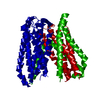 6jkdC 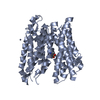 4lepS S: Starting model for refinement C: citing same article ( |
|---|---|
| Similar structure data |
- Links
Links
- Assembly
Assembly
| Deposited unit | 
| ||||||||||||
|---|---|---|---|---|---|---|---|---|---|---|---|---|---|
| 1 | 
| ||||||||||||
| Unit cell |
|
- Components
Components
| #1: Protein | Mass: 57626.559 Da / Num. of mol.: 1 Source method: isolated from a genetically manipulated source Details: UniProt ID: Q8EHE6 Source: (gene. exp.)  Shewanella oneidensis (strain MR-1) (bacteria) Shewanella oneidensis (strain MR-1) (bacteria)Strain: MR-1 / Gene: SO_1277 / Production host:  |
|---|
-Experimental details
-Experiment
| Experiment | Method:  X-RAY DIFFRACTION / Number of used crystals: 1 X-RAY DIFFRACTION / Number of used crystals: 1 |
|---|
- Sample preparation
Sample preparation
| Crystal | Density Matthews: 3.23 Å3/Da / Density % sol: 66.64 % |
|---|---|
| Crystal grow | Temperature: 293 K / Method: lipidic cubic phase / pH: 4 Details: 40% PEG 200, 100 mM NaCl, 100 mM Na acetate, pH 4.0 |
-Data collection
| Diffraction | Mean temperature: 100 K / Serial crystal experiment: N |
|---|---|
| Diffraction source | Source:  SYNCHROTRON / Site: SYNCHROTRON / Site:  SPring-8 SPring-8  / Beamline: BL32XU / Wavelength: 1 Å / Beamline: BL32XU / Wavelength: 1 Å |
| Detector | Type: DECTRIS EIGER X 9M / Detector: PIXEL / Date: Dec 20, 2017 |
| Radiation | Protocol: SINGLE WAVELENGTH / Monochromatic (M) / Laue (L): M / Scattering type: x-ray |
| Radiation wavelength | Wavelength: 1 Å / Relative weight: 1 |
| Reflection | Resolution: 3.5→47.53 Å / Num. obs: 8312 / % possible obs: 83 % / Redundancy: 3.6 % / Biso Wilson estimate: 79.72 Å2 / CC1/2: 0.961 / Rmerge(I) obs: 0.284 / Rrim(I) all: 0.328 / Net I/σ(I): 5.49 |
| Reflection shell | Resolution: 3.5→3.71 Å / Redundancy: 3.5 % / Rmerge(I) obs: 1.359 / Num. unique obs: 1295 / CC1/2: 0.293 / Rrim(I) all: 1.586 / % possible all: 83.4 |
- Processing
Processing
| Software |
| |||||||||||||||||||||||||||||||||||||||||||||||||||||||||||||||||||||||||||||
|---|---|---|---|---|---|---|---|---|---|---|---|---|---|---|---|---|---|---|---|---|---|---|---|---|---|---|---|---|---|---|---|---|---|---|---|---|---|---|---|---|---|---|---|---|---|---|---|---|---|---|---|---|---|---|---|---|---|---|---|---|---|---|---|---|---|---|---|---|---|---|---|---|---|---|---|---|---|---|
| Refinement | Method to determine structure:  MOLECULAR REPLACEMENT MOLECULAR REPLACEMENTStarting model: 4LEP Resolution: 3.5→47.53 Å / SU ML: 0.4697 / Cross valid method: FREE R-VALUE / σ(F): 1.33 / Phase error: 30.8325
| |||||||||||||||||||||||||||||||||||||||||||||||||||||||||||||||||||||||||||||
| Solvent computation | Shrinkage radii: 0.9 Å / VDW probe radii: 1.11 Å | |||||||||||||||||||||||||||||||||||||||||||||||||||||||||||||||||||||||||||||
| Displacement parameters | Biso mean: 65.71 Å2 | |||||||||||||||||||||||||||||||||||||||||||||||||||||||||||||||||||||||||||||
| Refinement step | Cycle: LAST / Resolution: 3.5→47.53 Å
| |||||||||||||||||||||||||||||||||||||||||||||||||||||||||||||||||||||||||||||
| Refine LS restraints |
| |||||||||||||||||||||||||||||||||||||||||||||||||||||||||||||||||||||||||||||
| LS refinement shell |
|
 Movie
Movie Controller
Controller



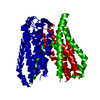
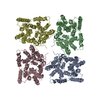


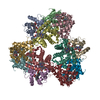
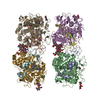
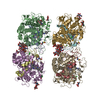
 PDBj
PDBj


